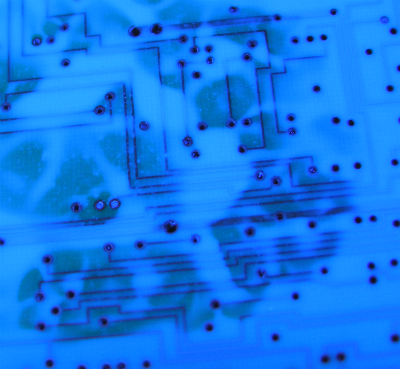by Eric Sari
When it comes to delamination on printed circuit boards (PCBs), don’t immediately start making adjustments in your process or selective conformal coating machines while checking for the cause of defects. First, check to see if the problem is a condition present on the batch of boards itself. Conformal coating delamination is generally caused by a condition present on the circuit assemblies and the issue is much easier to fix than your conformal coating equipment or the process itself. Poor adhesion of conformal coating on PCBs is frequently the result of poor environmental conditions in which the boards endured before arriving to the conformal coating workcell. The following are a few common issues to check for when troubleshooting the root cause of delamination of conformal coating on PCBs.
PCB Cleanliness
When poor adhesion and non-wetting conformal coating defects occur this is typically caused by issues of cleanliness when it comes to PCB’s. Adhesion is affected by laminate and component cleanliness. Contamination during the production process can be caused from cleaning residues, flux, and particulates. These possible contaminants should especially be watched for in a no-clean process because coating defects are just one of many potential issues caused by them. Addressing this issue will require the boards to be adequately cleaned before conformal coating.
Laminate Surface Incompatibility
Laminate surface incompatibility refers to when delamination occurs where wide areas of conformal coating peel off the circuit assemblies like strips of plastic. This is because the PCB surface energy is literally unable to bond with the conformal coating material being used. This doesn’t matter if the laminate is technically “clean” the coating still won’t adhere. Surface energy can be measured using a Dyne pen and it is best to work with the PCB supplier in resolving it.
Dewetting can often occur with the presence of quad flat packs (QFPs) or other components on the surface of a PCB. These substances are typically the presence of mold release agents on the component surface from the molding process. The presence of these traces on the component surface will cause problems. It will cause the coating to run and pool instead of laying even over the component surface.
To correct this issue, run the PCB through a cleaning system. For no-clean, clean the component top surfaces using fine tipped cotton swabs soaked in solvent. In addition, pre-heating the board to 50° C before applying the conformal coating will aid in helping the coating to stick and partly cure in place while still warm.
Contamination from Silicone
Contamination of silicone in any form on a PCB will prevent adhesion of conformal coatings. Once silicone contaminants are introduced to a PCB, removing it is difficult. Depending on the nature of what’s being used, a number of stages are generally required to adequately clean and reverse the contamination. This process is both time consuming and costly. Preventing silicone contamination all together is the ideal situation. Many manufacturers choose not to allow silicone into a process and merely eliminate the problems commonly associated with its contamination.
When these adhesion issues are checked for and appropriate actions taken to resolve them, return to running PCBs through coating and enjoy proper conformal coating bonds. It is highly encouraged to check for conformal coating and PCB adhesion on a regular basis to verify that the process is in control. If issues are discovered, immediate actions should be taken to correct the process.
For more information visit our Selective Conformal Coating page


